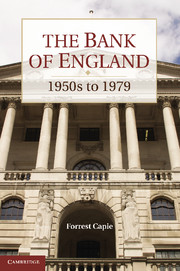Book contents
- Frontmatter
- Contents
- List of Illustrations
- List of Figures
- List of Tables
- Foreword by Mervyn King
- Preface
- Acknowledgements
- Abbreviations and Acronyms
- 1 Introduction and Overview
- 2 The Bank in the 1950s
- 3 The Monetary Setting and the Bank
- 4 The Bank's External Responsibilities to 1964
- 5 From Crisis to ‘Crucifixion’
- 6 Domestic Monetary Policy after Radcliffe
- 7 Other Activities and Performance
- 8 Sterling from Devaluation to Smithsonian
- 9 The Road to Competition and Credit Control
- 10 Competition and Credit Control
- 11 The Secondary Banking Crisis
- 12 Banking Supervision
- 13 Monetary Targets and Monetary Control
- 14 The Bank and Sterling in the 1970s
- 15 The Bank's Freedom to Operate
- 16 Epilogue
- Bibliography
- Index
- Titles in the series
14 - The Bank and Sterling in the 1970s
Published online by Cambridge University Press: 05 July 2011
- Frontmatter
- Contents
- List of Illustrations
- List of Figures
- List of Tables
- Foreword by Mervyn King
- Preface
- Acknowledgements
- Abbreviations and Acronyms
- 1 Introduction and Overview
- 2 The Bank in the 1950s
- 3 The Monetary Setting and the Bank
- 4 The Bank's External Responsibilities to 1964
- 5 From Crisis to ‘Crucifixion’
- 6 Domestic Monetary Policy after Radcliffe
- 7 Other Activities and Performance
- 8 Sterling from Devaluation to Smithsonian
- 9 The Road to Competition and Credit Control
- 10 Competition and Credit Control
- 11 The Secondary Banking Crisis
- 12 Banking Supervision
- 13 Monetary Targets and Monetary Control
- 14 The Bank and Sterling in the 1970s
- 15 The Bank's Freedom to Operate
- 16 Epilogue
- Bibliography
- Index
- Titles in the series
Summary
Although the Bank had long had responsibility for the exchange rate, in a sense since the eighteenth century, and from the 1930s it had managed the Exchange Equalisation Account (EEA) on behalf of the Treasury and was steeped in its roles as adviser, as an operator in the foreign-exchange markets, in the 1970s its task was to become less clear and more difficult. The breakdown of the Bretton Woods arrangements, the accompanying upheaval in currencies, sterling's problems as a reserve currency, and the ‘overhang’ of sterling balances from which the exchange rate could not easily be separated all contributed. As far as the exchange rate went, the Bank was subordinate to the Treasury, although in terms of what could be achieved and how, it still had some freedom and was central to decision making. It took a long time before anything resembling an exchange-rate policy emerged. For the first years of the decade, it was a case of reacting to events, hastily arranged consultations with the Treasury without a view as to what rate was desired or what reserves were wanted or ‘needed’. Efforts were concentrated on holding operations while a new system was designed. However, attempts at reform were abandoned in the wake of the oil-price hike of 1973–74. In rudderless Britain, things came to a head in the crisis of 1976. The wildly expansionist policies had failed.
- Type
- Chapter
- Information
- The Bank of England1950s to 1979, pp. 707 - 772Publisher: Cambridge University PressPrint publication year: 2010
- 2
- Cited by



